Learn About American Silver Eagles
The American Silver Eagle is the official silver bullion coin of the United States government. Today, Silver Eagles are by far the world's most popular silver coin. In the bullion industry, you will sometimes see its name abbreviated as "ASE." Each coin weighs 1 troy ounce in actual silver weight (ASW).
It was first minted in 1986 and has been produced by the millions every year since. This gorgeous and majestic coin is trusted by investors all over the world. Over the years, the mint has also released a number of collectible Silver Eagle coins with special finishes.
Bullion versions of the American Silver Eagle are primarily produced at the United States Mint at West Point. They are also struck at the San Francisco Mint and the Philadelphia Mint. U.S. law mandates that bullion Silver Eagles be minted in numbers large enough to meet demand.
Why Buy American Silver Eagle Coins?
Buying American Silver Eagle coins can make sense for both investors and collectors. The bullion Silver Eagle is the most famous silver bullion coin in the world. This allows for liquidity when compared to other silver coins or silver bars. You can buy Silver Eagles in the following ways:
- Single Silver Eagle Coins for sale
- Rolls of 20 Silver Eagle coins for sale
- Mint Sealed Monster Box of 500 coins for sale.
If the need arises to pay a bill when cash is short, American Silver Eagle bullion coins allows for this. This saves the investor from a large capital gains hit.
Below we'll explore the various types of Silver Eagles that have been issued from 1986 to the present day.
Bullion American Silver Eagles
The American Silver Eagle coin is what is meant when people use the term "Silver Eagle." The bullion Silver American Eagle has an unlimited mintage each year. These coins are are intended for investors rather than collectors. But, this does not mean that bullion Silver Eagles see no collector interest. There is a numismatic market for the first flawless Silver Eagles. The major coin grading services certify these coins for a small cost.
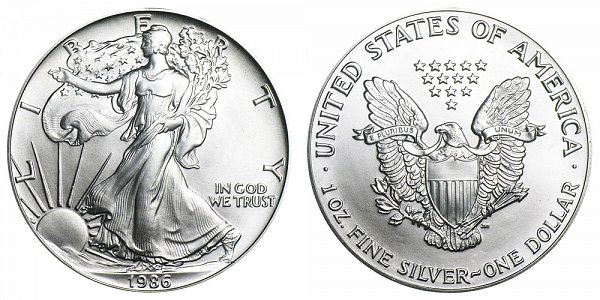
1986 American Silver Eagle, the first year of issue.
Bullion Silver Eagles do not carry a mint mark. This means that there is no way to determine which Mint struck any individual coin. Monster boxes, or bulk boxes of Silver Eagles, were once labeled with the name of the Mint that produced them. This has led to collectors paying a premium for specific mints. This resulted in a change in U.S. Mint policy. Now, all bulk monster boxes are sealed with a generic U.S. Mint packing strap.
The U.S. Mint does not sell bullion Silver Eagles directly to the public. Instead, these coins are sold through a network of Authorized Purchasers and distributors. After the 2008 Global Financial Crisis, investor demand for Silver Eagles spiked. This caused the mint to run out of coin blanks needed to make the Silver Eagle.
Proof American Silver Eagles
Proof American Silver Eagles are special numismatic versions of the Silver Eagle. Proof Silver Eagles carry a mint mark, unlike their bullion counterparts. In most years, this is the "W" mint mark of the West Point Mint. Proof Silver Eagles can also be struck at San Francisco or Philadelphia. These special coin sets will bear the "S" or "P" mint mark, as appropriate.
Silver Proof Eagles are not mass-produced on high-speed coin presses. First, carefully-polished coin blanks are hand-fed into coining presses. Next they are fitted with special polished dies which are engraved to show great detail. After being struck, these coins are sealed in a hard plastic coin capsules. The encapsulated coins are then shipped with a Certificate of Authenticity.
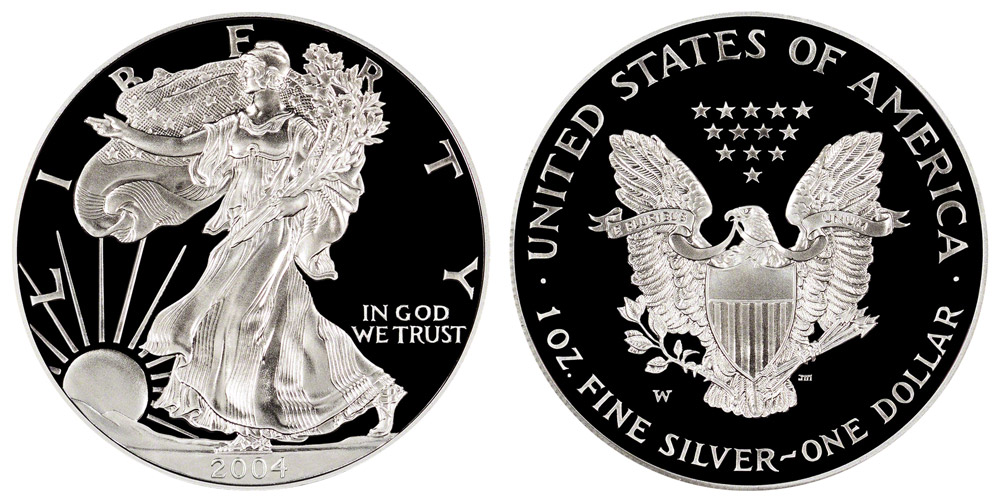
2004-W Proof American Silver Eagle.
Proof Silver Eagles have a mirror-like finish on the field (background). They also have "frosted" finishes on the devices (features). These effects are created by striking each many times in the coining press.
Proof Silver Eagles are minted to meet demand. Unlike bullion Eagles, the mint does sell these numismatic offerings directly to the public. They were subject to a product limit most years from 1986 through 2004.
Uncirculated American Silver Eagles
Uncirculated American Silver Eagles are sometimes referred to as Burnished Silver Eagles. They were first produced in 2006, to mark the 20th anniversary of the American Eagle coin program. Unlike proof coins, uncirculated Silver Eagles are produced using burnished coin blanks. This imparts a "satiny" finish to the coin's field.
Uncirculated Silver Eagles are a numismatic product, and carry the "W" mint mark of the West Point Mint. This mint mark is the easiest way to tell the uncirculated Silver Eagle from the bullion version. The proof American Silver Eagle and the Uncirculated Silver Eagle are minted each year.
American Silver Eagle Special Versions
Three types of American Silver Eagles have been made for special occasions. These coins were only offered in coin sets with a strict product limit. This makes each of these designs the most rare types of Silver Eagles on the market.
Reverse Proof American Silver Eagle
The Reverse Proof American Silver Eagle was first struck in 2006. This was to mark the 20th anniversary of the American Eagle program. Unlike the Proof Silver Eagle, the Reverse Proof coin is minted only on special occasions. The Reverse Proof American Silver Eagle has frosted fields and mirror-like relief features.
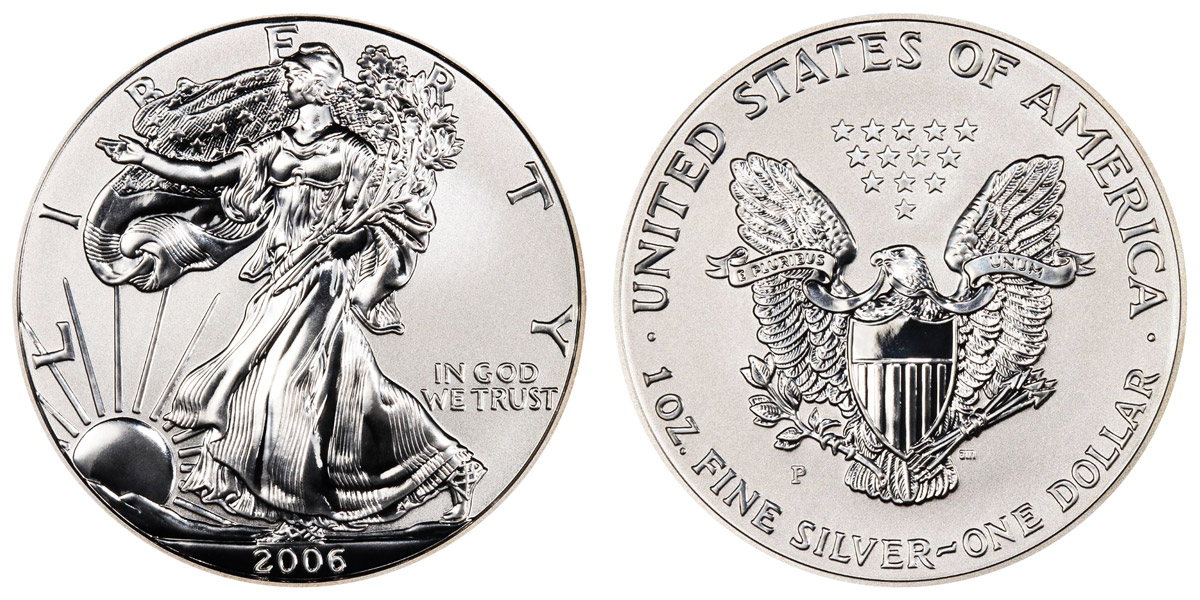
2006-P Reverse Proof American Silver Eagle.
Reverse Proof American Silver Eagle Release Dates
2006-P: Released in 3-coin 20th Anniversary Set (Proof-W, Burnished-W, and Reverse Proof-P)
2011-P: Released in 5-coin 25th Anniversary Set (Proof-W, Burnished-W, Bullion-S, Reverse Proof-P, Burnished-S)
2012-S: Released in 2-coin San Francisco Silver Eagle Set (Proof-S, Reverse Proof-S)
2013-W: Released in 2-coin West Point Silver Eagle Set. (Reverse Proof-W, Enhanced Uncirculated-W [see below])
Enhanced Uncirculated American Silver Eagle
The Enhanced Uncirculated American Silver Eagle features three types of finishes.
- Mirror-like proof finish.
- Lightly frosted "satin" finish
- Heavily frosted finish.
This type of finish on a Silver Eagle was introduced in the 2013 two-coin West Point Silver Eagle Set. The 2013-W Enhanced Uncirculated Silver Eagle has frosted satin fields on both sides.
The obverse features a frosted "satin" finish to the fields. This sets off the mirror-like proof finish on the mountains in the background of the scene. The frosted Liberty's figure, sun, and sunbeams stand out against the satin background. The inscriptions "LIBERTY" and "IN GOD WE TRUST" also seem to "pop" above the fields.
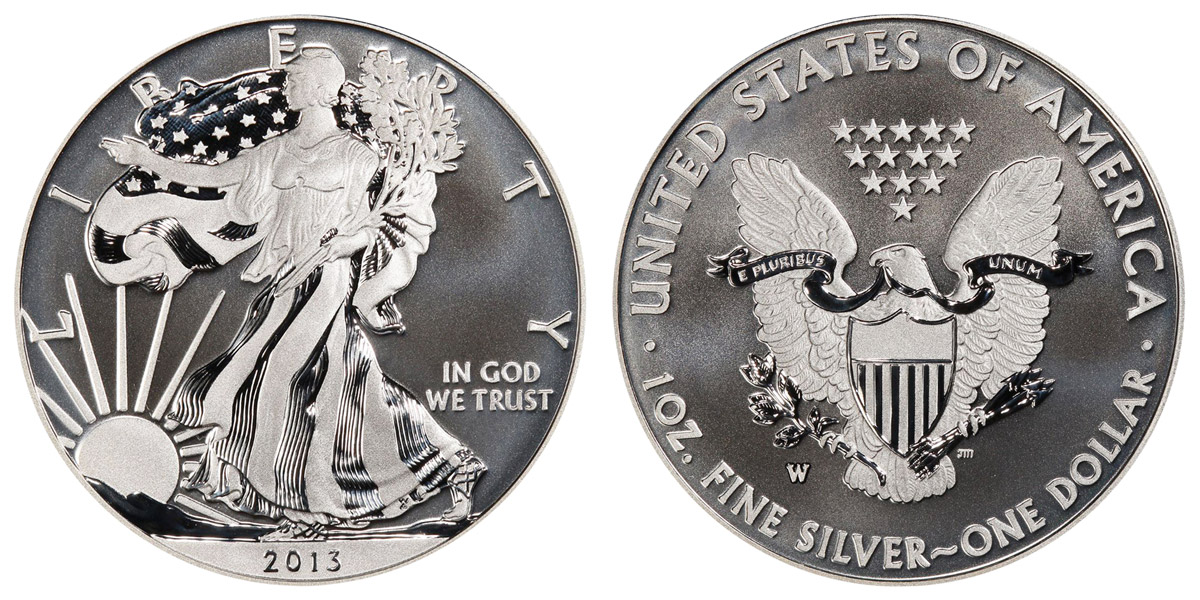
2013-W Enhanced Uncirculated American Silver Eagle.
The 2013-W is the only American Silver Eagle in an Enhanced Uncirculated finish from the U.S. Mint.
The Enhanced Reverse Proof American Silver Eagle is a recent, rare Silver Eagle. This design retains the frosted fields of the Reverse Proof coin. This unique design debuted in the 2019 two-coin "Pride Of Two Nations" silver coin set. This set was issued in conjunction with the Royal Canadian Mint. The Silver Maple Leaf included in the set also has a unique finish.
The History Of The American Silver Eagle
The American Silver Eagle was authorized by Title II of Public Law 99-61: The Liberty Coin Act of 1985. This law was ordered by the Secretary of the Treasury. It stated:
- To "mint and issue, in quantities sufficient to meet public demand."
- Mint coins which are 40.6 millimeters in diameter and weigh 31.103 grams.
- Contain .999 fine silver.
- Have a design symbolic of Liberty on the obverse side; and of an eagle on the reverse side.
This law also authorized where the the silver should come from. This includes the U.S. Strategic and Critical Materials Stockpile. Congress tried to prevent the Federal government from dumping silver. This included nearly 140 million ounces of stockpiled silver.
The result of their efforts led to the Liberty Coin Act. This act provided the government with a profit. It also provided the American public with its first government-issued silver investment product.
The first one troy ounce American Silver Eagles were struck at the San Francisco Mint on October 29, 1986. On November 24, enough Silver Eagles had been struck to open sales to the public.
American Silver Eagle Demand Greater Than Expected
The plan behind the Liberty Coin Act was to draw down government stockpiles of silver. The first American silver investment coin created a rush of excitement. After this initial rush of excitement low silver prices dampened demand. But demand for the American Silver Eagle jumped in the late 1990s. Annual Silver Eagle demand grew from 3.6 million coins in 1996 to 9.2 million coins sold in 2000.
The Secretary of the Treasury told Congress that there was at most two more years worth of silver left. In response, the "Support of the American Eagle Silver Bullion Program Act" (Public Law 107-201) was passed in 2002. The Act allowed the Secretary of the Treasury to buy silver on the open market.
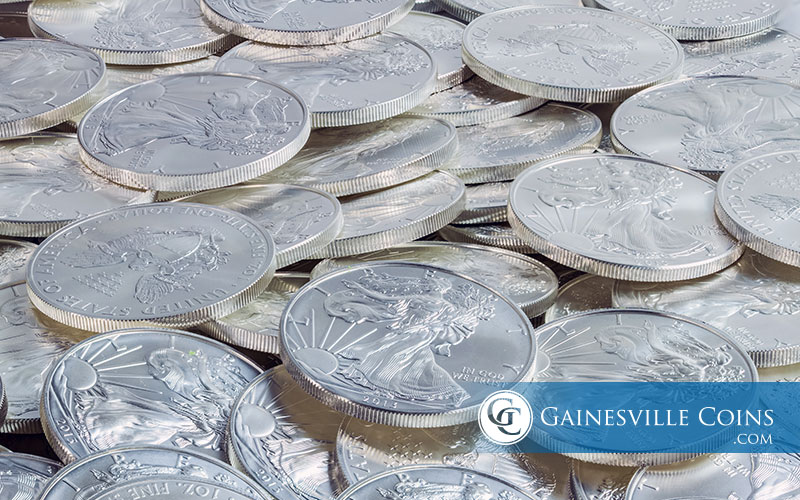
A pile of Brilliant Uncirculated American Silver Eagles.
The Global Financial Crisis of 2008 brought investor demand for safe haven assets. The stock markets crashed, and governments cut interest rates to unprecedented lows. Demand for American Silver Eagles outstripped the U.S. Mint's ability to meet it.
You can view the silver price today on our precious metals spot price charts.
The market went from $5/oz silver in 2000, to nearly $50/oz silver in 2011. (Annual American Silver Eagle sales went from 9.2 million coins in 2000 to 40 million coins in 2011.)
The sudden crush of orders caught blank suppliers off-guard. Due to this shortage, the Mint suspended production of proof Silver Eagles in August 2008.
Shortages continued into 2009. This forced the Mint to cancel proof and uncirculated Silver Eagle production.
Silver Eagle bullion coin annual mintages grew from 9 million oz in 2007 to a peak of 47 million in 2015.
Top Five Mintage Years For The American Silver Eagle
2015: 47,000,000
2014: 44,006,000
2013: 42,675,000
2011: 40,020,000
2016: 37,701,500
The Symbolism Of The American Silver Eagle Design
The American Silver Eagle showcases the classic grace of America's Coin Renaissance at the turn of the 20th century. It shows a clean, modern interpretation of one of the United State's earliest emblems.
The Obverse Design of the American Silver Eagle
The Silver Eagle reprises the Adolph Alexander Weinman Walking Liberty half dollar design. This design features Lady Liberty striding confidently forward. Her right hand gestures toward a rising sun. She carries boughs of laurel and oak in the crook of her left arm, symbolizing strength in both peace and war.
The Reverse Design of the American Silver Eagle
The reverse of the American Silver Eagle is an original design by U.S. Mint engraver John Mercanti. The design is based on the Great Seal of the President of the United States. A strong heraldic American bald eagle dominates the field. The eagle's wings frame an inverted triangle of thirteen stars. These stars represent the original Thirteen Colonies.
The bald eagle grasps an olive branch in its right talon, and six arrows in its left talon. The olive branch in the right talon symbolizes the desire of the United States for peace. The arrows in the left talon symbolize the ability of the United States to defend itself if needed. The ribbon held in the eagle's beak bears the national motto of the United States: "E Pluribus Unum."
DID YOU KNOW?
John Mercanti is the most prolific artist/engraver in U.S. Mint history. He holds more than 200 coin and medal designs to his credit during his 36 years with the Mint. He was the twelfth Chief Engraver of the U.S. Mint from 2006 until his retirement in 2010.
The American Eagle bullion coin program isn't only about silver. American Gold Eagle coins were introduced alongside the Silver Eagle in 1986. The American Platinum Eagle followed in 1997. The American Palladium Eagle was introduced in 2017.
New Type 2 Silver Eagle Reverse Design
Beginning in the second half of 2021, the U.S. Mint introduced a new reverse design for its flagship silver bullion coin. Replacing Mercanti's heraldic eagle, the new design created by artist Emily Damstra depicts a bald eagle in mid-flight. The eagle carries an olive branch in its talons and features incredibly realistic feather textures. The inscriptions on the coin remain the same, but they are stretched around the outer rim of the design.

The new Type 2 American Silver Eagle reverse design debuted in 2021.
All types of 2021 American Silver Eagle coins are struck from 1 troy oz of .999 fine (99.9% pure) silver. As mentioned above, the U.S. Mint does not sell bullion Silver Eagles to the public. Instead, the Mint sells bullion Silver Eagles in bulk to approved wholesalers. These wholesales then sell them to intermediate suppliers and bullion dealers. The U.S. Mint does sell numismatic, or collectible, versions of the American Silver Eagle to the public.
Follow the link to our American Silver Eagles for sale to shop the available inventory of Silver Eagle coins at Gainesville Coins.

Steven Cochran
A published writer, Steven's coverage of precious metals goes beyond the daily news to explain how ancillary factors affect the market.
Steven specializes in market analysis with an emphasis on stocks, corporate bonds, and government debt.
